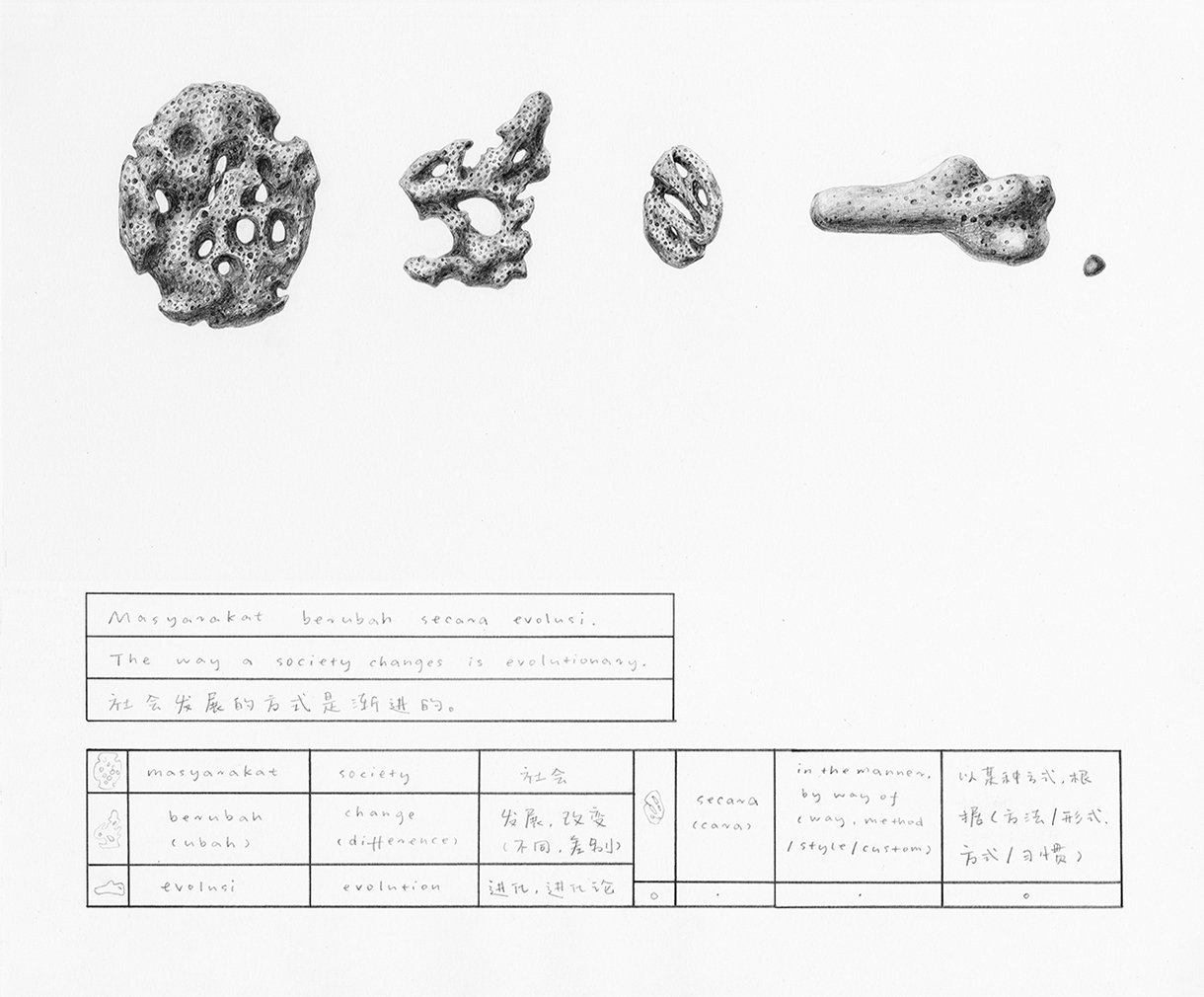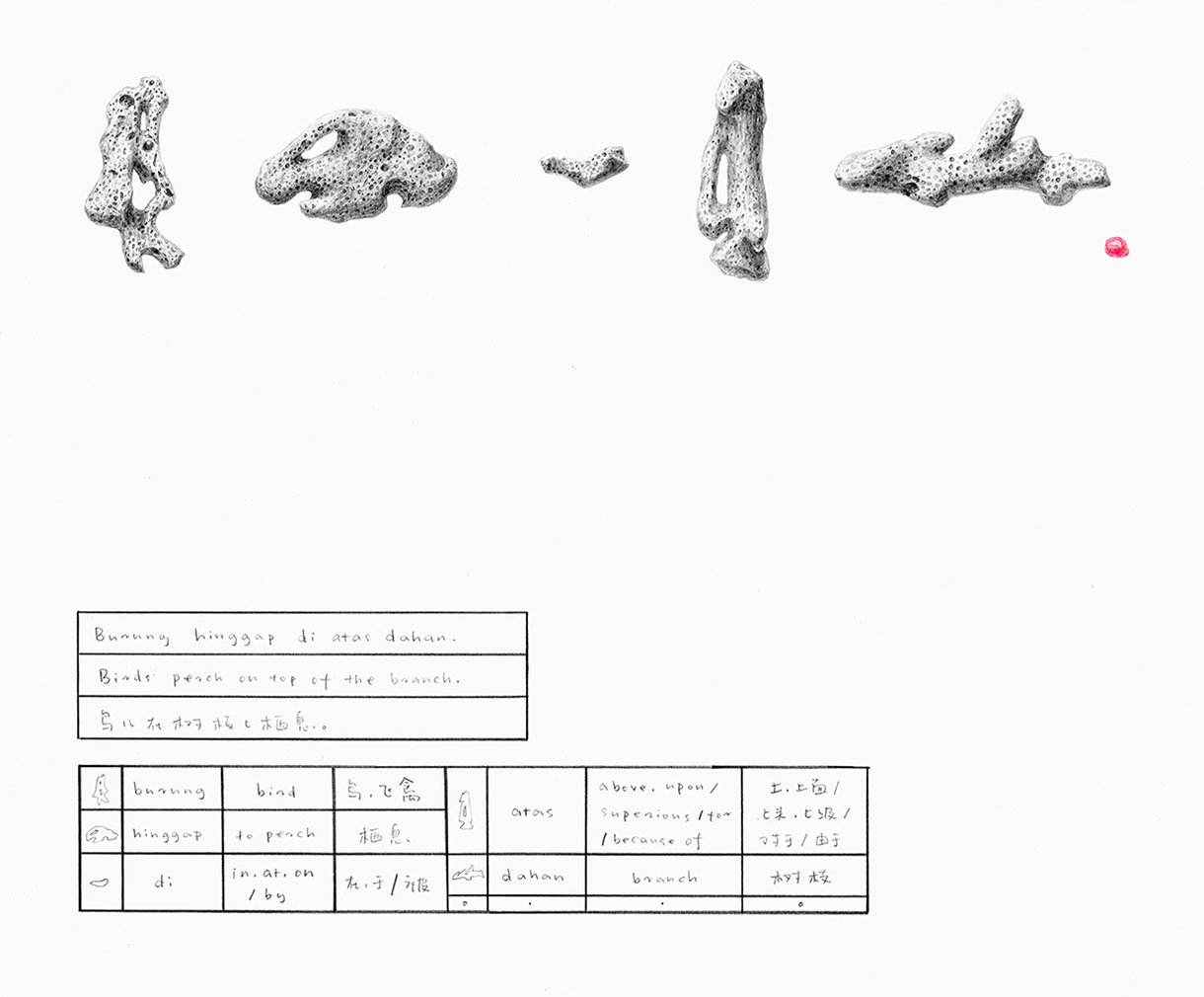






















Chang Yuchen: Coral Dictionary (60 Sentences)
Beijing Commune, 09/21-11/09, 2024
Beijing Commune is pleased to present “Coral Dictionary (60 Sentences),” Chang Yuchen's first solo exhibition with the gallery, showcasing a series of sixty pencil drawings on paper. Since her residency in Dinawan, Malaysia in 2019, Chang has been unwaveringly working on her unique language revolving around the corals she encountered and collected on the island. Employing writing, drawing, and performance, the Coral Dictionary series with a delicate and porous quality unfolds the rich textures in handwriting, translations, and communications, gently yet resolutely addressing themes of perception, understanding, and the relationship between the self and the surrounding.
In Chang's semiotic system taking corals as signs, she uses extremely detailed strokes of sharpened pencil to depict the stranded and naturally dried coral bodies. Neatly arranged, images of corals appear as a deep dive into nature, reminiscent of botanical and zoological illustrations. Nevertheless, they are not bodies of biological specimens for scientific eyes, nor will they be cataloged into different coral subclasses. On the other hand, what fascinates Chang is the unique shape each coral takes on during its symbiotic interaction with other organisms in the ocean as it grows and lives. With her intricate touches, Chang devotes herself to the indelible lives and memories in the seemingly monotonic forms that could once be reductively categorized into one kind of species.
As if following the rhythms of each coral’s breath, the detailed depiction of undulations and cavities reflects Chang's sympathy for the living experience in the folds. Each of the sixty paintings in the exhibition corresponds to sixty example sentences from Kamus Sari, a dictionary in Malay, Chinese, and English. All styles of writing and rhetorical forms—description, narrative, aphorism, and lyricism—inevitably appear a bit stiff in the print font of this linguistic manual. Yet when the artist stumbled upon the dictionary on Dinawan, she was immediately engrossed by the sentences that are infiltrated with life under waves of turmoil and integration in the local society. The sentences act like a mirror for Chang an outsider to the island and entice a reexamination of her own knowledge of, under modernization. For Chang, who is often torn by the loose, if any, symmetry in the translation between two divergent languages, Chinese and English, these sentences raise questions against the logos and ethos of translation and communication.
Lying at the heart of her rumination and art practices, “language” and ‘translation’ are crucial ways of life for Chang, who was born in northern China and spent more than ten years in a foreign land in the United States. Embodied experience on Dinawan has brought her an alternative type of relationship between the self and the surroundings. Whereas coral does not speak nor write yet constantly “communicates with the wind, the sea, and the hermit crabs,” the communication formed between the unformed words with the local people impelled Chang to recognize language as more than just a medium constituted by signs: “Language without words is like a soul without a body. It is free because it is intangible.” Moreover, for the artist, “translation” is not simply an act of converting one language into another, but also the forming of any kinds of feelings, perceptions, and expressions: translation is “a state of existence. Living is translation.”
In a logographic manner, each character in the Coral Dictionary arrives at its semantic meaning by provoking Chang’s imagination and feelings with the coral’s labyrinthic shape. Symbols in the Coral Dictionary appear to be both a divination and Chang's diarial whisper; Chang's performative reading alternates between a ritual and an intimate conversation that goes against the grain. For Chang, the often linear language and communication following the laws of economy conceive an idea of time that is, to use her words in describing the difference between logogram and phonogram, “impossible to linger.” The Coral Dictionary is not, after all, a language that overrides time.
——
Special thanks to Dinawan Island and Offshore Residency Program
Text: Huang Sijia
Exhibition Design: Xi Jiajia
Video: Sheng Wei
Photo: Yang Wei, Xi Jiajia
常羽辰:珊瑚辞典(60句)
北京公社,09/21-11/09, 2024
北京公社于2024年9月21日呈现常羽辰个展“珊瑚辞典(60句)”。这次展览展出一系列六十幅纸上素描作品。从2019年开始,常羽辰围绕着她是年于马来西亚金之岛参加驻地期间偶遇和珍集的珊瑚骸骨展开了一场悠长的语言创作项目。通过书写、绘画、表演等形式,《珊瑚辞典》系列作品以细腻和多孔的质地,展开了关于书写、翻译和交流过程中的复杂纹理,蹒跚却坚决地探索着有关感知、理解、个体与周遭关系的主题。
在常羽辰以珊瑚为符号的语言系统中,她用极为细致的素描笔触刻画出金之岛上搁浅风干的珊瑚骸骨。这些珊瑚是海洋与岛屿自然生态中的产物,在有序的排列下,几乎像是动植物百科写真绘本一样展开。但在《珊瑚辞典》中,它们并非科学目光下的生物学样本,也不属于纲目的分门别类。让常羽辰着迷的是,珊瑚因其在生长过程中与海洋里其他生物互动共生的特性,每一株都得以形成独特的形状。艺术家所悉心描绘的是一度可以被化约的形态各异里不可化约的生命与记忆。
像是不错过珊瑚的每一次呼吸那样细腻地描绘珊瑚体上的每一次起伏与洞隙,折射出常羽辰对褶皱中生命浓度的敏锐感知。展览中的六十幅作品分别对应着一本马中英三语字典中的六十句例句。所有说明、记叙、箴言、抒情等各类的文体以及修辞形式在这本功能手册的印刷字体下难免显得有些僵硬。即便如此,常羽辰在岛上偶遇这本字典时立刻被句子中透漏着这个在振荡与交融中形成的当地社会的气息和肌理所吸引。 这些反倒是一个陌生的外人更能嗅闻和抚摸的语句像是一面反映出自身现代化的镜子,让扭打在中文和英文两种语言翻译之间本就不严丝合缝的对称中的常羽辰,重新思考翻译与交流的逻辑与伦理。
“语言”与“翻译”是出生于中国北方、在美国异乡生活十余年的常羽辰与周遭相处至关重要的工具与方式,也是她思考与创作的核心。金之岛上的生命体验给带来了对于自我与周遭环境关系的重新认识。正如同珊瑚不言不语,却能“与风、与海、与寄居蟹交流”,在金之岛上不成形的只言片语间形成的交流,让常羽辰更加确信语言不仅仅是一种符号媒介:“没有文字的语言就像没有身体的魂魄,它是自由的,因为它是无形的。”“翻译”对常羽辰来说也不仅仅是两种语言符号之间互相转化,而是将对于感受的表达甚至任何感知的转换视作一种翻译:翻译是“一种存在的状态。活着就是翻译。”
《珊瑚辞典》中的每一个珊瑚字元以类似象形文字的方式出现,不仅依纯粹外形的相似而通过珊瑚迷宫般外形引发的感受来抵达语义。《珊瑚辞典》看似是一场通灵之术,也是常羽辰日常书写的窃窃私语;跟随常羽辰的表演阅读既是一场仪典,也是一次一反往常的亲密交流。在传统交流中,对时间的认知仿佛总是在经济法则中被倒置了,正如当艺术家试图描述拼音文字与象形文字的区别时所说的,“线性的时间反而让时间无法流连”。《珊瑚辞典》终究不是凌驾于时间的工具。
——
致谢金之岛及Offshore驻地项目
文字:黄思嘉
展陈设计:席家佳
录像:盛伟
摄影:杨威、席家佳
